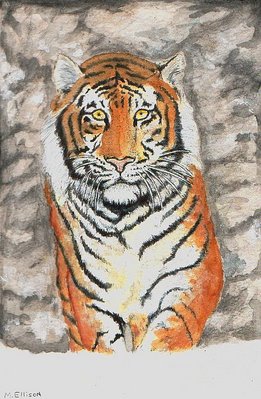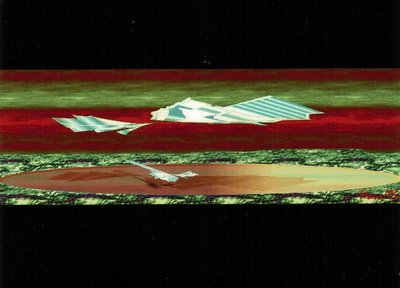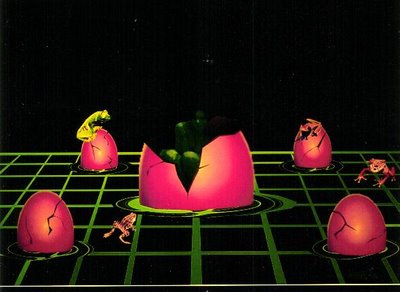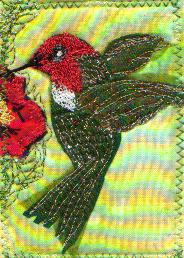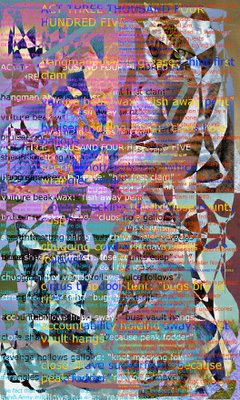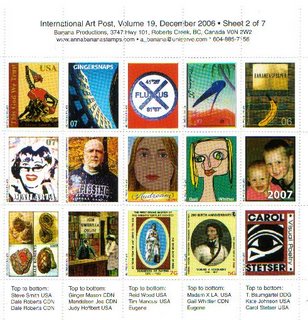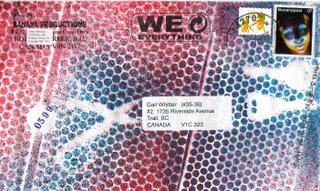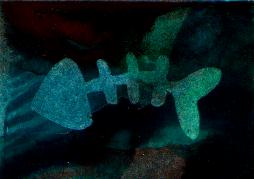Wednesday, January 31, 2007

PEACE NO MORE WAR
Mailart Project: No Deadline.
Any size. Any media.
Send to: Pati Bristow
P.O.Box 3127
Los Altos, CA 94024 USA
Documentation at: http://pati-bristow.livejournal.com
Thank You!
Monday, January 29, 2007
MAIL ART CALL
Art Splinters for a Non-Ordinary Reality
Format: postcard
Technique: Free
Online catalogue: www.realtano.it
Deadline: 30-06-07
Send works to:
Maurizio Follin
Via M.te Cervino 27
30173 Favaro V.to - Venezia, Italy
Please include name; address; country; email address & website (if one exists).
All works MUST BE sent by post with postage stamps. Art will not be returned, but will belong to "Mostre Improbabili 7" & will be displayed at the "Arte, Profumi, Sapori" exhibition - Az.Vitivinicola Biologica Marina Sgubin Scrio, Dolegna del Collio GO, Italy.
Art Splinters for a Non-Ordinary Reality
Format: postcard
Technique: Free
Online catalogue: www.realtano.it
Deadline: 30-06-07
Send works to:
Maurizio Follin
Via M.te Cervino 27
30173 Favaro V.to - Venezia, Italy
Please include name; address; country; email address & website (if one exists).
All works MUST BE sent by post with postage stamps. Art will not be returned, but will belong to "Mostre Improbabili 7" & will be displayed at the "Arte, Profumi, Sapori" exhibition - Az.Vitivinicola Biologica Marina Sgubin Scrio, Dolegna del Collio GO, Italy.
Saturday, January 27, 2007
TRIVIA
* The lion costume in the movie, The Wizard of Oz was made from real lions.
* Scientists have determined that fungi are more closely related to human beings and animals than to other plants.
* A "lost world" exists in the Indonesian jungle that is home to dozens of unknown animal and plant species.
* The total combined weight of the world's ant population is heavier than the weight of the human population.
* "Jaws" is the most common name for a goldfish.
* Camel's milk has 10 times more iron than cow's milk.
* More people have a phobia of frogs than rats.
* Woodpecker scalps, porpoise teeth and giraffe tails have all been used as money.
* The oldest pig in the world lived to the age of 68.
* In Nepal, cow dung is used for medicinal purposes.
* A killer whale's heart beats 30 times a minute under water, 60 times a minute on the surface.
* The word animal is derived from the Latin "anima" = "soul" & "life".
* Mosquitos like damp clothes and the colour blue.
* If cows eat too many carrots, their milk tastes bitter.
* One tiny alfalfa leafcutter bee can pollinate carrots 20 times better than its larger, noisier, more irritable honey bee cousins.
* You can lead a horse to water, but a pencil must be lead.
* If a pig loses his voice is it disgruntled?
* An ant can survive for up to 2 weeks underwater.
* On an average day, a queen bee lays about 1500 eggs.
* Bees have been known to cure rheumatism.
* Vellum takes its name from the medieval paper it resembles that was made from animal skin.
* One of the medieval names for owl was "night hag"; it was said to be a witch in bird form.
* Scientists have determined that fungi are more closely related to human beings and animals than to other plants.
* A "lost world" exists in the Indonesian jungle that is home to dozens of unknown animal and plant species.
* The total combined weight of the world's ant population is heavier than the weight of the human population.
* "Jaws" is the most common name for a goldfish.
* Camel's milk has 10 times more iron than cow's milk.
* More people have a phobia of frogs than rats.
* Woodpecker scalps, porpoise teeth and giraffe tails have all been used as money.
* The oldest pig in the world lived to the age of 68.
* In Nepal, cow dung is used for medicinal purposes.
* A killer whale's heart beats 30 times a minute under water, 60 times a minute on the surface.
* The word animal is derived from the Latin "anima" = "soul" & "life".
* Mosquitos like damp clothes and the colour blue.
* If cows eat too many carrots, their milk tastes bitter.
* One tiny alfalfa leafcutter bee can pollinate carrots 20 times better than its larger, noisier, more irritable honey bee cousins.
* You can lead a horse to water, but a pencil must be lead.
* If a pig loses his voice is it disgruntled?
* An ant can survive for up to 2 weeks underwater.
* On an average day, a queen bee lays about 1500 eggs.
* Bees have been known to cure rheumatism.
* Vellum takes its name from the medieval paper it resembles that was made from animal skin.
* One of the medieval names for owl was "night hag"; it was said to be a witch in bird form.
Friday, January 26, 2007
 Art by Luis Diaz Garcia, Spain
Art by Luis Diaz Garcia, SpainMAIL ART CALL:
Theme: Any Desire
Info: Any medium. Any technique. Documentation to all.
Deadline: 31.08.2007
Send to: Luis Diaz Garcia
Laponia, 13-1'A
28030 Madrid
Espana
email: raven65@telefonica.net
All works will be displayed at:
http://desirescall.blogspot.com/
Saturday, January 20, 2007

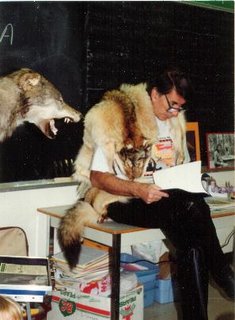
TO BE WOLF
Endless circle, shrunken perspective
wolves know the feel of their smallness
inch by intimate inch
their hourly wakeful passion
connecting
love as need -
is there yet a dream?
- as if they saw but one horizon.
Perhaps it is for us to imagine
if we were wild
and tamed from birth
in one confusion
how life is like
confined
without understanding
alert
without greed
but with our necessity
because we must be wolf.
- By Owen R. Neill, Canada
http://wolfspoet.blogspot.com/
Thursday, January 18, 2007
Saturday, January 13, 2007
MAIL ART - NETWORKING ART by Ryosuke Cohen
Recently, I have observed many signs that make me feel as if Mail Art is drawing to a close, and that there are many past publications that could be seen as "compilations" of Mail Art. Quite a few predecessors of Mail Art have passed away, including Ray Johnson (USA), the Father of Mail Art, G.A. Cavellini (Italy), Robert Rehfeldt (Germany), G. Deisler (Germany), Robin Crozier (England), Carlo Pittore (USA), and others. This is probably also because exchange by mail in the age of computers is considered primitive, and after the end of the COLD WAR between the East and West, the necessity of correspondence between those two different worlds has been lost. On the other hand, I have been regularly receiving mail art by mail and fax, in response to my BRAIN CELL PROJECT dating from the year 1985, which has been numbered issue no. 652 as of June 2006. Every time I receive mail art, I am pleased to see more and more new participants. After making them a collage of their drawings, designs, logos, seals, stickers and the like, I make it a rule to send the finished project back to each participant. Mail Art is far from finishing. I appreciate the role of collaboration in Mail Art. It is important to have new participants each time, but it is more important to be evoked by other mail artists' ideas from within the large and deep Network with a diverse range of expressions and concept. I can make mail artists' ideas more interesting by actively availing myself of seals and stamps and other materials sent from others and through my own printed matter. What is more, I can give other mail artists the feeling that they can utilize other's art and collaborate their ideas.
We have the Doppler effect in physics. The sound coming nearer to us becomes narrower between the sonic waves and sounds higher and more urgent in our ears. On the contrary, as waves travel away from us they get relatively wider and the sound appears lower. There are a variety of physical sounds around us: for example, the sound of cars coming and going. This phenomena is also true of art. Some art comes towards me, while other art goes away. People very often ask me how we can know good from bad in art. It does not matter whether this representational painting is good in composition and colour and technique, or whether that piece of abstract art is good in balance and rhythm. I don't think it important to generally decide which style of art is better than others. That is to say, traditional ways of thinking about art is fading away from me. I often (think) other artists only use limited new techniques in spite of what is called "originality" and "individuality", to the constant efforts predecessors had made for so long. A variety of works of modern art with too much false assertion of originality and individuality are also traveling away from me.
When I was at art school, I used to draw or paint representationally, moved by Cezanne's composition, and Matisse's brightness and his own style of plane. Later on I had some exchange with members of Gutai Group, so I learned new concepts of art through contemporary art. Consequently I have been participating in Mail Art Networking. I claim that this was a natural changeover and has no inconsistency with my personal concept of art. We need no large studio or storage space for paintings. Whoever wants to take part in mail art does so freely. We can deny the authority of the traditional art world, because mail artists directly exchange their own artworks. The fascination for Mail Art, more than twenty years ago, approached me with a high sound. Even now the collaborative concept of Mail Art is coming closer to me with a much higher sound.
We don't have any fixed "ism" in the infinite expanse of the Mail Art Network. Postcards, Xeroxes, collages, drawings, photos, CGs, CDs and other forms are sent in by mail, fax, e-mail, etc. We are overwhelmed by the diversity of how mail art members think and express themselves. We realize that countless "isms" are mixed together in a state of chaos that is represented in Mail Art. Of course, we don't copyright our works. Interested in others' works, we add something to them or combine them together, and then send them back or forward them on to a third party. We occasionally find them changed into pieces with quite an unexpected concept.
At a glance, the jungle looks as if it is made up of gigantic trees, but the fact is that the rainforests in the Amazon of South America consists of numerous species that cohabit harmoniously: ferns and mosses parasitic to the gigantic trees, very tiny insects that hide themselves under the fallen leaves, insects camouflaging in dead leaves and twigs against the enemies, puny insects swarming together as a threat, birds displaying their existences with colourful feathers and a shrill cry and many other mammals and birds. We really wonder at how diverse these living things are. We can learn from the rain-forest that there are a multitude of LIFE FORMS. We are not chained to any fixed "ism" as this frees us from constraint, nor do we care for copyright - we prefer to revise and copy others' works in a free and easy style. In such a network there is the possibility of our experiencing much by communication of mail art. This is the very LIFE FORM that we can experience in a variety of ways.
Networking Art is art that enables us to be a praying mantis in camouflage, or butterflies flying on colourful wings.
Nowadays I have come to realize that we are all part of a FRACTAL, and that I can be a piece of that FRACTAL, and that I can create art, in a way that extends beyond myself as an individual, in communication with infinite mail artists' ideas.
In the same way we appreciate the various kinds of LIFE FORMS in the Amazon, we can experience a multitude of art forms in the Mail Art Network. It is only human beings who can experience plural LIFE FORMS, by which we can acquire a genuine sense of new creation.
Ryosuke Cohen (June 2006)
Translated by Kazumori Murakami
We have the Doppler effect in physics. The sound coming nearer to us becomes narrower between the sonic waves and sounds higher and more urgent in our ears. On the contrary, as waves travel away from us they get relatively wider and the sound appears lower. There are a variety of physical sounds around us: for example, the sound of cars coming and going. This phenomena is also true of art. Some art comes towards me, while other art goes away. People very often ask me how we can know good from bad in art. It does not matter whether this representational painting is good in composition and colour and technique, or whether that piece of abstract art is good in balance and rhythm. I don't think it important to generally decide which style of art is better than others. That is to say, traditional ways of thinking about art is fading away from me. I often (think) other artists only use limited new techniques in spite of what is called "originality" and "individuality", to the constant efforts predecessors had made for so long. A variety of works of modern art with too much false assertion of originality and individuality are also traveling away from me.
When I was at art school, I used to draw or paint representationally, moved by Cezanne's composition, and Matisse's brightness and his own style of plane. Later on I had some exchange with members of Gutai Group, so I learned new concepts of art through contemporary art. Consequently I have been participating in Mail Art Networking. I claim that this was a natural changeover and has no inconsistency with my personal concept of art. We need no large studio or storage space for paintings. Whoever wants to take part in mail art does so freely. We can deny the authority of the traditional art world, because mail artists directly exchange their own artworks. The fascination for Mail Art, more than twenty years ago, approached me with a high sound. Even now the collaborative concept of Mail Art is coming closer to me with a much higher sound.
We don't have any fixed "ism" in the infinite expanse of the Mail Art Network. Postcards, Xeroxes, collages, drawings, photos, CGs, CDs and other forms are sent in by mail, fax, e-mail, etc. We are overwhelmed by the diversity of how mail art members think and express themselves. We realize that countless "isms" are mixed together in a state of chaos that is represented in Mail Art. Of course, we don't copyright our works. Interested in others' works, we add something to them or combine them together, and then send them back or forward them on to a third party. We occasionally find them changed into pieces with quite an unexpected concept.
At a glance, the jungle looks as if it is made up of gigantic trees, but the fact is that the rainforests in the Amazon of South America consists of numerous species that cohabit harmoniously: ferns and mosses parasitic to the gigantic trees, very tiny insects that hide themselves under the fallen leaves, insects camouflaging in dead leaves and twigs against the enemies, puny insects swarming together as a threat, birds displaying their existences with colourful feathers and a shrill cry and many other mammals and birds. We really wonder at how diverse these living things are. We can learn from the rain-forest that there are a multitude of LIFE FORMS. We are not chained to any fixed "ism" as this frees us from constraint, nor do we care for copyright - we prefer to revise and copy others' works in a free and easy style. In such a network there is the possibility of our experiencing much by communication of mail art. This is the very LIFE FORM that we can experience in a variety of ways.
Networking Art is art that enables us to be a praying mantis in camouflage, or butterflies flying on colourful wings.
Nowadays I have come to realize that we are all part of a FRACTAL, and that I can be a piece of that FRACTAL, and that I can create art, in a way that extends beyond myself as an individual, in communication with infinite mail artists' ideas.
In the same way we appreciate the various kinds of LIFE FORMS in the Amazon, we can experience a multitude of art forms in the Mail Art Network. It is only human beings who can experience plural LIFE FORMS, by which we can acquire a genuine sense of new creation.
Ryosuke Cohen (June 2006)
Translated by Kazumori Murakami
Monday, January 01, 2007
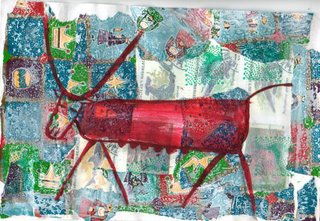

Artworks sent in by Bridie Knight, Australia [http://bridesnightie.blogspot.com/ or bridieknight.blogpot.com]
GO POSTAL MAIL ART CALL
Send art on subject of Postal Services. Postcard size or smaller (flexible enough to fit into a post box). Who sends, who receives, who collects and sorts, who delivers? What journey did that item take from point A to point B?
Less and less people use the postal system in favour of electronic communication. What's it all about, how does it make you feel? Let me know through art.
I will send you something in return if you remember to put your postal address.
Bridie Knight
P.O. Box 2002
Rangeview, 3132
Victoria, Australia
